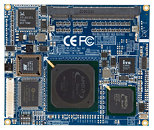- Joined
- Oct 9, 2007
- Messages
- 47,895 (7.38/day)
- Location
- Dublin, Ireland
| System Name | RBMK-1000 |
|---|---|
| Processor | AMD Ryzen 7 5700G |
| Motherboard | Gigabyte B550 AORUS Elite V2 |
| Cooling | DeepCool Gammax L240 V2 |
| Memory | 2x 16GB DDR4-3200 |
| Video Card(s) | Galax RTX 4070 Ti EX |
| Storage | Samsung 990 1TB |
| Display(s) | BenQ 1440p 60 Hz 27-inch |
| Case | Corsair Carbide 100R |
| Audio Device(s) | ASUS SupremeFX S1220A |
| Power Supply | Cooler Master MWE Gold 650W |
| Mouse | ASUS ROG Strix Impact |
| Keyboard | Gamdias Hermes E2 |
| Software | Windows 11 Pro |
Fairly invisible to the retail buyer, the Geode processor platform has been AMD's embedded computing product for several years in continuity. The Geode chip still finds use in embedded machines. Although the processor isn't in shortage and is available in both new-old stock or available on order by the chip-maker itself, the dated DDR memory it supports seems to be in short supply. To maintain memory compatibility with current memory standards, AMD added support for DDR2 memory.
The compatibility is brought about by a memory adapter and a new BIOS. The newer DDR2 memory will not enhance performance. It will make DDR2 memory operate at the data-rates of the older DDR standard, but will certainly keep the platform alive with support for the memory standard that's easily available in the market presently. The use of DDR2 memory is also expected to marginally reduce power consumption.

View at TechPowerUp Main Site
The compatibility is brought about by a memory adapter and a new BIOS. The newer DDR2 memory will not enhance performance. It will make DDR2 memory operate at the data-rates of the older DDR standard, but will certainly keep the platform alive with support for the memory standard that's easily available in the market presently. The use of DDR2 memory is also expected to marginally reduce power consumption.

View at TechPowerUp Main Site



